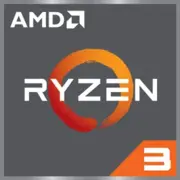AMD Ryzen 3 7330U

AMD Ryzen 3 7330U: A Balance of Performance and Battery Life for Budget Laptops
(March 2025)
AMD Ryzen U-series processors have long established themselves as reliable solutions for thin and light laptops. The Ryzen 3 7330U, introduced in 2023, continues to be popular in the budget segment thanks to its successful combination of energy efficiency and sufficient performance. Let's explore who this chip is suitable for in 2025, how it compares to competitors, and what to consider when choosing a device.
Architecture and Process Technology: Zen 3 on 7 nm
The codename Barcelo-R indicates the evolution of the Ryzen 5000 lineup for mobile devices. Despite using TSMC's 7-nanometer FinFET process rather than more modern 5nm or 4nm technologies, the processor remains relevant due to the optimized Zen 3 architecture.
- 4 cores and 8 threads: Multithreading allows for efficient use in office applications, browsers, and light creative tasks.
- Base frequency — 2.3 GHz, maximum Turbo frequency — 4.3 GHz: Under short bursts of heavy load (e.g., opening "heavy" files), the processor can boost its speed, but during prolonged tasks, the frequency drops to about 3.5 GHz due to limited TDP.
- Integrated graphics Radeon Graphics (Vega): 6 compute units (CUs) clocked up to 1.8 GHz. This is sufficient for gaming at low settings or working with 4K video via HDMI.
- L3 Cache — 8 MB: Smaller compared to Ryzen 5/7 (16 MB), but adequate for basic tasks.
Architecture Features:
- Support for PCIe 3.0 (rather than 4.0 like the Ryzen 7000), which limits SSD speeds, although there is no difference for SATA drives.
- Precision Boost 2 technology for automatic boosting based on load and temperature.
Power Consumption and TDP: 15 W for Ultrabooks
With a TDP of 15 W, the Ryzen 3 7330U is ideal for compact laptops with passive or modest active cooling. In idle mode, the chip consumes less than 5 W, and under peak load (e.g., video rendering) it can go up to 25 W, but only briefly.
Power-Saving Technologies:
- AMD Cool'n'Quiet: Dynamic shutdown of unused cores.
- Adaptive Power Management: OS integration for frequency adjustments based on battery charge.
Thermal Package: Even in thin chassis (like the Lenovo IdeaPad 5), the temperature rarely exceeds 75°C, preventing throttling during everyday tasks.
Performance: Real-World Scenarios
Office Work and Multitasking
- Geekbench 6: 1537 (Single-Core), 3733 (Multi-Core). For comparison: Intel Core i3-1315U (2023) scores around ~1600/4100, but costs 20-30% more.
- Running 30 tabs in Chrome + Microsoft Teams + Excel works smoothly without lag.
- Converting PDF to Word takes 8-10 seconds for an average-sized file.
Multimedia
- Video: Streaming 4K (YouTube, Netflix) is smooth, but for editing in DaVinci Resolve, the resolution will need to be lowered to Full HD.
- Audio: Processing tracks in Audacity poses no problems.
Gaming
- CS2: 720p, low settings — 45-60 FPS.
- Fortnite: 720p, Performance mode — 30-40 FPS.
- Indie Games (Hollow Knight, Stardew Valley): 1080p/60 FPS.
Turbo Mode: In gaming, the processor maintains a frequency of 3.8-4.0 GHz for about 10-15 minutes before dropping to 3.2 GHz.
Use Cases: Who is the Ryzen 3 7330U Suitable For?
- Students: Working with texts, presentations, Zoom lectures.
- Office Workers: Multitasking in browsers and office suites.
- Everyday Users: Surfing, streaming, light photo editing.
- Travelers: Compact laptops weighing up to 1.5 kg (Acer Swift 3, HP Pavilion Aero).
Not Suitable For:
- Gamers expecting 60 FPS in AAA titles.
- Video editors working with 4K materials.
Battery Life: Up to 10 Hours in Mixed Usage
With a battery capacity of 50 Wh (typical for ultrabooks):
- Video Playback: Up to 9 hours (brightness at 150 nits).
- Office Work: 7-8 hours.
- Gaming: 2-3 hours.
Tip: Choose models with IPS or OLED screens with low power consumption (e.g., Full HD+ with a 60 Hz refresh rate).
Comparison with Competitors
AMD Ryzen 5 7520U (Zen 2, 4 cores):
- Cheaper by $50, but 15% lower performance.
- Older architecture — not the best choice in 2025.
Intel Core i3-1315U (10 cores, 12 threads):
- Higher multithreaded performance (+10%), but poorer energy efficiency. Intel laptops are often heavier.
Apple M1 (8 cores):
- 2-3 times faster in Single-Core, but devices start at $900.
Conclusion: The Ryzen 3 7330U is optimal for laptops priced between $400-600.
Pros and Cons
Strengths:
- Low device prices.
- Energy efficiency.
- Sufficient performance for basic tasks.
Weaknesses:
- No support for PCIe 4.0 and DDR5.
- Weaker graphics compared to Intel Iris Xe.
Laptop Selection Recommendations
1. Type of Device: Ultrabooks (ASUS Zenbook, Lenovo Yoga) or budget models (Acer Aspire 3).
2. RAM: Minimum 8 GB (preferably 16 GB for multitasking).
3. Storage: SSD 512 GB NVMe (PCIe 3.0 x4).
4. Display: Full HD, matte finish for use in bright environments.
2025 Model Examples:
- HP 255 G9: $450, 8 GB RAM, 256 GB SSD.
- Lenovo IdeaPad Slim 5: $550, 16 GB RAM, 512 GB SSD.
Final Conclusion
The AMD Ryzen 3 7330U is a solid choice for those seeking an affordable laptop with long battery life and sufficient performance for everyday tasks. It may lag behind modern chips in demanding scenarios, but its price and optimization keep it relevant in 2025.
Who is it Suitable For:
- Users with a budget of up to $600.
- Those who value portability and battery life.
- Anyone not requiring maximum performance but seeking balance.
If you’re not chasing the latest technology and want to save money, the Ryzen 3 7330U remains a worthy option.
Basic
CPU Specifications
Memory Specifications
GPU Specifications
Miscellaneous
Benchmarks
Compared to Other CPU
Share in social media
Or Link To Us
<a href="https://cputronic.com/cpu/amd-ryzen-3-7330u" target="_blank">AMD Ryzen 3 7330U</a>